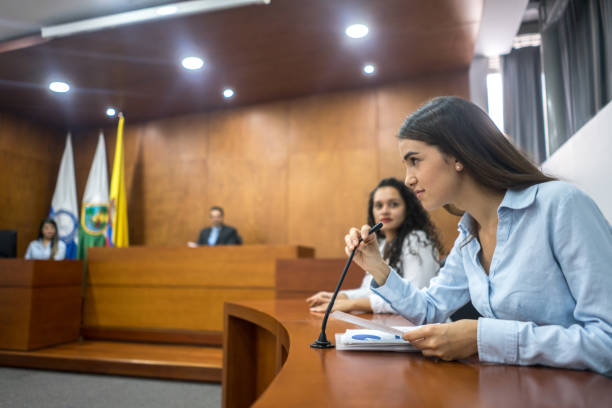Exactly how to Enhance Your Case with Engaging Trial Presentations: Specialist Tips for Attorney
Exactly how to Enhance Your Case with Engaging Trial Presentations: Specialist Tips for Attorney
Blog Article
Navigating the Intricacies of Test Presentations: Tips for Seamless Shipment and Engaging Debates
In the world of legal process, the art of trial discussion stands as an important factor of success. The intricacies inherent in test discussions require a fragile balance of method, ability, and finesse.

Comprehending Test Purposes
To properly navigate a trial, it is vital to have a clear understanding of the goals that need to be achieved. Before stepping right into the courtroom, legal groups should define their objectives and desired results. These purposes serve as leading principles throughout the test, forming methods and influencing decision-making procedures.
Recognizing test objectives involves a thorough analysis of the instance, legal criteria, and the client's benefits. Trial Presentations. It calls for a precise exam of the truths, recognizing vital problems, and anticipating potential difficulties. By establishing details and measurable goals, lawyers can tailor their arguments and presentations to align with the desired outcomes
Furthermore, a clear understanding of test purposes enables lawful teams to prioritize proof, witnesses, and legal debates efficiently. It permits for the growth of a meaningful narrative that resonates with the judge and jury, reinforcing the overall instance presentation.

Organizing Proof Efficiently
Having a clear understanding of test objectives lays the foundation for arranging proof effectively in lawful proceedings. By aligning the discussion of proof with the preferred results of the test, lawful groups can reinforce their debates and improve their persuasiveness.
An additional key element in organizing evidence effectively is developing a logical flow. Offering evidence in a sequential and meaningful way can aid construct a compelling story that supports the lawful disagreements being made. Additionally, utilizing aesthetic aids such as timelines, graphs, or charts can better improve the organization of evidence and aid in making clear complicated relationships or series of events.
Additionally, ensuring that all proof provided is admissible and appropriate to the case is crucial. Unnecessary or inadmissible evidence can interfere with the stamina of the debate and possibly damage the credibility of today party. As a result, a thorough testimonial and option procedure should be carried out to consist of only the most impactful and lawfully sound evidence in the test presentation.
Crafting Convincing Narratives
Crafting compelling narratives plays an essential role in providing convincing disagreements during legal procedures. When creating a story for a trial presentation, it is necessary to establish a clear story that highlights vital points and connects visit the website them in a systematic fashion. By weaving with each other proof, testimony, and legal debates right into a cohesive and influential narrative, legal specialists can successfully advocate for their customers and raise the probability of a desirable end result in the courtroom.
Mastering Visual Aids
Effective use of aesthetic aids is essential to enhancing the influence and quality of test presentations. Visual help, when utilized purposefully, have the power to streamline intricate information, strengthen bottom lines, and leave an enduring perception on the discretionary. To grasp visual aids in trial presentations, it is vital to ensure that they are clear, concise, and pertinent to the disagreements being made.
When incorporating aesthetic aids, such as charts, charts, timelines, or photos, into a trial discussion, it is vital to keep them aesthetically appealing yet professional. The visuals need to match the verbal disagreements, offering a visual representation of the details being discussed without overwhelming the target market with unnecessary details.
Furthermore, practicing with the aesthetic aids in advance is essential to ensure a seamless shipment during the trial. Acquainting oneself with the web content, transitions, and timings of each visual aid can help maintain the flow of the presentation and prevent technical glitches that might emerge.
Delivering Impactful Closing Arguments
A compelling closing debate offers as the culmination of a test discussion, enveloping the core story and encouraging the judge and jury in the direction of a desirable decision. Begin by describing the main arguments that sustain your customer's position, stressing why the evidence offered throughout the check it out test sustains your narrative.
In addition, incorporating psychological allure can even more enhance your closing disagreement. Ultimately, a well-crafted closing argument ought to leave a long lasting impression, compelling the judge and jury to rule in your customer's support.
Final Thought
Finally, mastering trial discussions involves comprehending goals, organizing evidence, crafting narratives, utilizing aesthetic aids, and providing impactful closing disagreements. By applying these approaches successfully, legal representatives can present their case perfectly and make compelling disagreements in the court room. It is vital to navigate the intricacies of trial presentations with accuracy and ability to attain success in legal proceedings.
By straightening the discussion of proof with the desired end results of the trial, legal groups can reinforce their debates and improve their persuasiveness (Trial Presentations). To grasp visual aids in trial discussions, it is vital to make sure that they are clear, concise, and appropriate to resource the arguments being made
An engaging closing debate offers as the culmination of a trial discussion, enveloping the core narrative and persuading the court and jury towards a favorable choice. Begin by outlining the major arguments that support your client's setting, emphasizing why the proof offered throughout the trial sustains your narrative.In conclusion, mastering trial presentations involves recognizing goals, organizing proof, crafting stories, using aesthetic help, and providing impactful closing disagreements.
Report this page